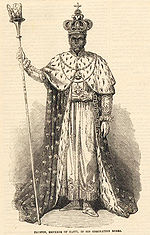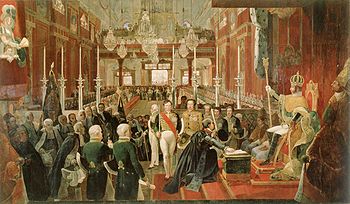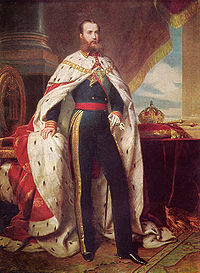- Coronations in the Americas
-
- Note: this article is one of a set, describing coronations around the world.
- For general information related to all coronations, please see the umbrella article Coronation.
Coronations in the Americas were held in the following countries:
Contents
By country
Brazil
 Emperor Faustin I of Haiti at his coronation.
Emperor Faustin I of Haiti at his coronation.
Brazilian emperors, of which there were two (Pedro I and Pedro II), were crowned with the Imperial Crown of Brazil in a Catholic Coronation Mass. The constitution required the monarch to have reached their eighteenth birthday before the ceremony could take place. Brazil abolished its monarchy in 1889.
Haiti
Jean-Jacques Dessalines, one of the founding fathers of Haiti, proclaimed himself Emperor of Haiti soon after its independence. He was crowned on 6 October 1804 in Le Cap, but was assassinated two years later. A Kingdom of Haiti was established in 1811 by Henri Christophe, another leader in the Haitian independence struggle. He was crowned in June 1811 in a lavish ritual presided over by Archbishop Corneil Breuil of Milot, but committed suicide in 1820. Faustin-Élie Soulouque later proclaimed himself to be Emperor Faustin I of Haiti; he was crowned in an extremely elaborate ceremony held in Port-au-Prince on 18 April 1852, but was forced to abdicate in 1859, bringing his nascent Haitian imperium to an end.[1]
Mexico
Main articles: First Mexican Empire and Second Mexican EmpireMexico has twice been a monarchy ruled by emperors. Agustín I ruled from 1822 to 1823 after Mexico's independence from Spain; he was crowned in a lavish ceremony on 21 July 1822 at the Catedral Metropolitana de Mexico in Mexico City, placing the diadem on his own head in the manner of Napoleon I.[2] Agustin I was overthrown in March 1823, and the Mexican monarchy abolished.
Mexico's second monarch was Maximilian I, an Austrian archduke who was persuaded to take the newly-revived Mexican throne in 1864 by Napoleon III of France (whose troops, in conjunction with Mexican conservatives and nobility, had instituted it). His consort was Charlotte of Belgium, or Empress Carlota of Mexico. The second Imperial Crown of Mexico and a matching sceptre were manufactured for an intended coronation at the Catedral Metropolitana, but the ceremony was never carried out due to the instability of Maximilian's regime. The Second Mexican Empire lasted for over three years. Maximilian was defeated by Republican forces led by Mexican President Benito Juárez and executed in 1867, bringing his empire to an end.
United States
James J. Strang, a would-be successor to Joseph Smith, Jr. in the leadership of the Latter-day Saint movement from 1844–56, openly established an ecclesiastical monarchy on Beaver Island, Michigan in 1850. On 8 July of that year, he staged an elaborate coronation ceremony complete with a throne, wooden sceptre, breastplate and a crown described by one observer as "a shiny metal ring with a cluster of glass stars in the front".[3] "King Strang" reigned over his followers until 16 June 1856, when he was assassinated by two disgruntled subjects. His people were driven from the island, and Strang's kingdom—together with his royal regalia—vanished.
For coronations in the pre-annexation Kingdom of Hawaii, see Coronations in Oceania.
Some observers compare the American presidential inauguration to a coronation,[4] with the American constitutional requirement for a presidential oath identical to the oaths required of the world's monarchs. Some historians and comparative government experts indicate that the former stems directly from the latter.[5] The pomp and pageantry of the modern event is comparable in some ways to monarchical coronations.[6]
See also
References
- ^ "Haiti Main". Homepage.mac.com. Archived from the original on August 3, 2008. http://web.archive.org/web/20080803022400/http://homepage.mac.com/stlazare/Haiti/Haiti%20Main.html. Retrieved 2008-11-07.
- ^ "casa imperial de Mexico". Casaimperial.org. http://www.casaimperial.org/augustin.htm. Retrieved 2008-10-12.
- ^ "AmericanHeritage.com / For His Was the Kingdom, and the Power, and the Glory ... Briefly". Americanheritage.com. http://www.americanheritage.com/articles/magazine/ah/1970/4/1970_4_4.shtml. Retrieved 2008-10-12.
- ^ Paul Harri in New York (2005-01-09). "Bush 'the king' blows $50m on coronation | World news | The Observer". London: The Observer. http://www.guardian.co.uk/world/2005/jan/09/usa.theobserver. Retrieved 2008-10-12.
- ^ "Online NewsHour: Inauguration 2001: The Inauguration and the Constitution". Pbs.org. http://www.pbs.org/newshour/inauguration/lesson_constitution.html. Retrieved 2008-10-12.
- ^ Richard Stengel (January 12, 2001). "Inauguration or Coronation?". Time.com. http://www.time.com/time/nation/article/0,8599,94983,00.html?iid=chix-sphere. Retrieved 2008-10-12.
Categories:
Wikimedia Foundation. 2010.


